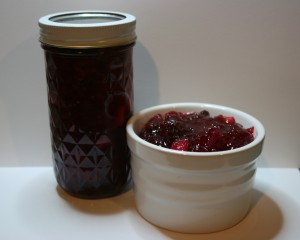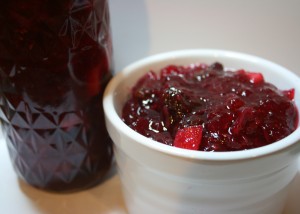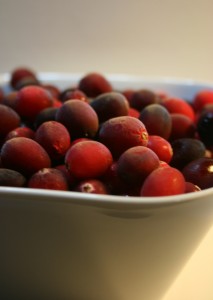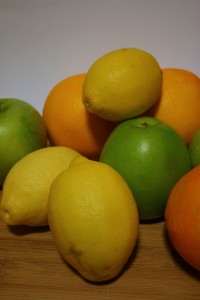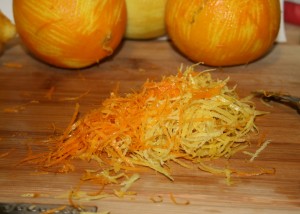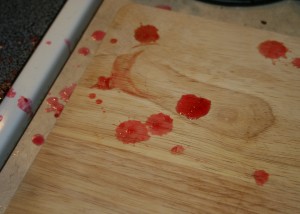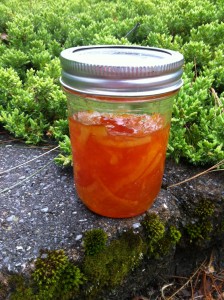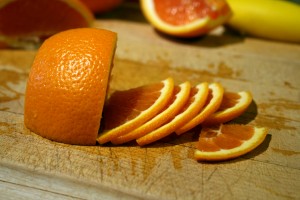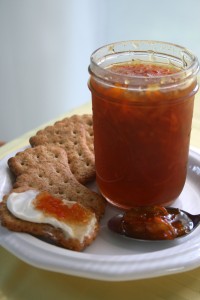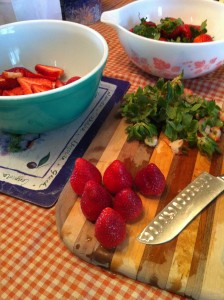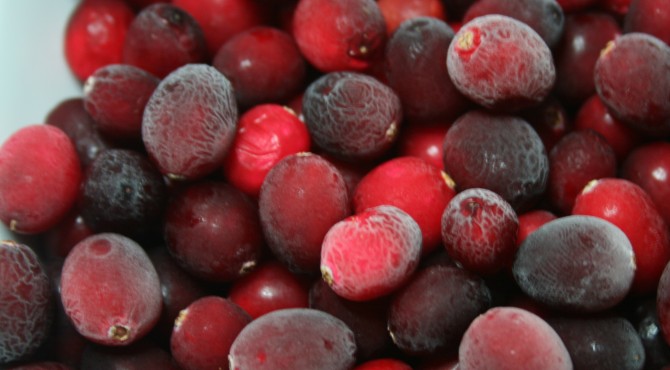
Autumn in New England means a lot of things. Leaves changing, the chill in the air, pumpkin flavored EVERYTHING. It’s also cranberry harvest time. Thanksgiving is coming, and no turkey dinner would be complete without cranberry sauce.
I will admit that I am a big fan of jellied cranberry sauce from a can. It’s yummy and comforting. However, it can’t hold a candle to home made.
When I started making my own cranberry sauce, I used to use the basic recipe from the bag consisting of cranberries, sugar, and water. Those ingredients, when combined over heat, do certainly make something one could consider cranberry sauce. It’s just not particularly good.
This recipe came to me a few years ago from a friend of mine, and I’ve been making it every year since. The addition of apples, citrus, and sweet raisins can make a cranberry skeptic into a fan.
This year, I decided to go big. The recipe takes a bit of time to make, and so I figured I’d just make all the sauce I’d need for the entire holiday season in one go. That means there was canning involved.
Cranberry Sauce
Ingredients
- 1 (12-ounce) bag of fresh cranberries, cleaned
- 1 3/4 cups sugar
- 1 Granny Smith apple, peeled, cored, and chopped
- 1 orange, zest grated and juiced
- 1 lemon, zest grated and juiced
- 3/4 cup raisins
- Cook the cranberries, sugar, and 1 cup of water in a saucepan over low heat for about 5 minutes, or until the skins pop open.
- Add the apple, zests, and juices and cook for 15 more minutes.
- Remove from the heat and add the raisins.
- Let cool, and serve chilled.
Simple! Couldn’t be easier! Then, just put it in a jar and you’re all set! Piece of cake!
Okay, well, actually the recipe is really easy, and if you’re just making a single batch for nearly immediate consumption, it works out quite well. When you decide to triple the recipe and then can it, things get slightly trickier.
Let me walk you through how the process actually goes.
First off, put the giant pot of water for canning on the stove. This will take about 3 years to boil, so get it started early. Put the clean jars in so that they can boil and sterilize.
Next, take the three bags of cranberries out of the freezer. They’ll be in the back, under all the other stuff. Dump them into a bowl. Now, you’ll need to sort through them, pulling out any little bits of stem or any shady looking cranberries. Your fingers will get cold. Rinse the berries off and put them in the pot. You will second guess the size of the pan you have chosen, but will go with it anyway. You hope this isn’t a mistake.
Add the recommended amount of water.
Do the math for the amount of sugar you need for a triple batch of sauce. Check the math. Check it one more time. Measure out the sugar, trying not to think about it. Dump it into the pot with the water and cranberries. You will now have a mass of frozen cranberries with an uncomfortable amount of sugar on top. This is perfectly normal. Turn on the heat.
While your cranberry-sugar monstrosity thaws, it’s time to deal with the other fruit. Peel the apples. This takes way longer than you think it should. Every time. Cut the apple into tiny little pieces. Admire your excellent knife skills. Turn your attention to the citrus fruit. Look for the zester. It will not be in the drawer where you think it should be. Ask other utensils if they’ve seen it. Once you find it, remove the zest from the citrus, careful not to get any of the pith. This will yield a lot of zest. *Added benefit: Your hands will smell like citrus for hours.
By this time, the cranberry sauce over on the stove should have started to heat up. You know things are progressing when you can hear the hiss and pop of the berries exploding. This is a good thing. Once most of the berries have started popping, add the zest and the apple pieces. Stir well.
Cut the zested fruit in half. Juice said fruit into the pot of cranberry sauce. *Pro Tip: Squeeze citrus fruit into your hand over the pot in order to catch any rogue seeds. Nothing ruins Thanksgiving like biting down on a lemon seed.
Let the sauce cook for a good 15 minutes. This will help release the pectin from the apples, helping your cranberry sauce gel later on. When everything is nicely cooked, turn off the heat.
Once the sauce is ready and the jars are sterilized, it’s time to put the two together. Suddenly remember that you have to add the raisins. Dump them in and stir. Then you’re ready to can.
I’m going to let you in on a little secret. Every photo you’ve ever seen of someone in a pristine apron lovingly ladling jam into a jar with a serene smile is a lie. These calm people are not spooning molten hot fruit-and-sugar based napalm into tiny glass jars. They’re all staged. Real canning is messy, serious business. There are reasons why I never post photos of canning in progress; it’s not pretty. By the time I’m done, my counter top looks like something out of Dexter.
Once the jars are filled, the rims have been wiped clean, and the rings have been screwed on tight (“Yup, I’ll just grab this jar and screw on this metal ring. Oh, that’s right, it’s filled with magma.”), then they go back into the giant pot of water to boil for 15 minutes. After that, it’s a simple matter of letting them cool.
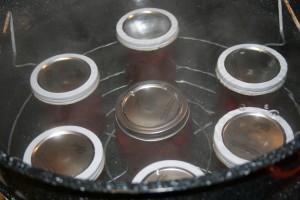
All joking aside, it is a lot of work, but getting all this done ahead of time will save me a lot of heartache in the end. I always wind up cooking lots of complicated things for holiday gatherings; it’s who I am. Having this one thing done early will come in handy.
